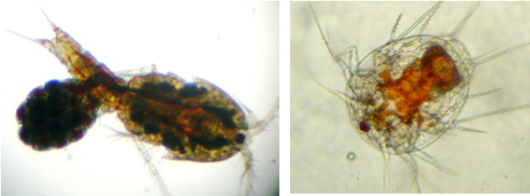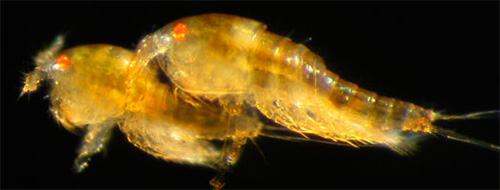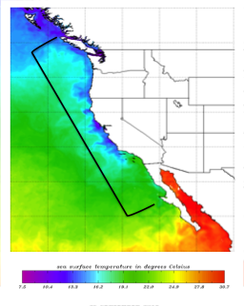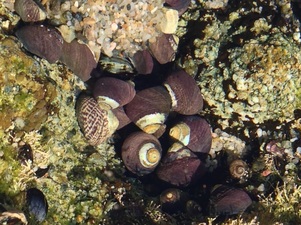Genomics of hybrid breakdown and speciation in the copepod Tigriopus californicus
|
Research on the evolutionary genetics of Tigriopus has been a focus of the Burton lab for over 25 years. T. californicus is a harpacticoid copepod that inhabits rocky pools in the splash zone. Geographically separated populations show high levels of genetic divergence. Laboratory crosses between populations typically result in F1 hybrid vigor; but when F1's are intercrossed, the F2's show a consistent reduction in physiological performance. Understanding the molecular genetic basis of this F2 breakdown is a primary research goal. In recent years, we have focused on the interactions between nuclear and mitochondrial genes that function in cellular energy metabolism. |
Molecular identification of fish eggs
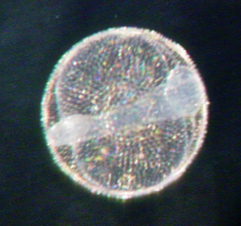 Fish egg that is unidentifiable without the use of molecular techniques.
Fish egg that is unidentifiable without the use of molecular techniques.
Marine Protected Areas (MPAs) have been established along the coast of California. This study provides a baseline for monitoring fish spawning in the MPAs offshore of Scripps Institution of Oceanography. Studies of fish eggs complement diver surveys and trawls, which until now have been the primary source of information about the fish species in these MPAs. Egg surveys provide definitive evidence of local spawning activity, clarifying the role of the MPAs as breeding grounds for multiple species.
Using vertical plankton net tows, we collected eggs from the plankton off Scripps Pier. Because most eggs are morphologically indistinguishable, molecular identification is necessary. DNA is amplified and species-specific primers are used to identify the most common species. The PCR products are sequenced and compared to published databases of DNA barcodes.
To date, over 7600 eggs from 39 species have been identified, including several not previously known to breed in this area (e.g. Cynoscion parvipinnis), which may represent northward range expansions in breeding activity. In the future, this survey can be used as a baseline to compare shifting populations and spawning patterns of species that may be affected by both the MPAs’ protection and broader oceanographic changes associated with global warming.
Using vertical plankton net tows, we collected eggs from the plankton off Scripps Pier. Because most eggs are morphologically indistinguishable, molecular identification is necessary. DNA is amplified and species-specific primers are used to identify the most common species. The PCR products are sequenced and compared to published databases of DNA barcodes.
To date, over 7600 eggs from 39 species have been identified, including several not previously known to breed in this area (e.g. Cynoscion parvipinnis), which may represent northward range expansions in breeding activity. In the future, this survey can be used as a baseline to compare shifting populations and spawning patterns of species that may be affected by both the MPAs’ protection and broader oceanographic changes associated with global warming.
Local adaptation in intertidal invertebrates
|
Latitudinal gradients in environmental stressors may result in adaptive divergence among populations. Consequently, when assessing the potential impact of global climate change, it is important to determine if geographically distinct conspecific populations vary in thermal tolerance. Where such differences occur, insight into the underlying mechanisms is key to better predict how species will respond to global warming; whether plasticity or local adaptation is responsible for population-specific thermal tolerances will affect populations’ vulnerability to local extinction.
The challenging physical conditions of the rocky intertidal make it an ideal environment for investigating such questions. Our research focuses on conspecific populations of the splash pool copepod Tigriopus californicus and the intertidal marine snail Chlorostoma funebralis that experience a latitudinal gradient in thermal environments. We have identified adaptive differentiation among geographically distinct populations from northern and southern California and are currently investigating the molecular mechanisms underlying these differences in heat tolerance. Recent work assessed the potential role of population-specific gene expression in local adaptation to thermal stress, and findings suggest differential expression of molecular chaperones such as heat shock proteins may contribute to varying thermal tolerance in both T. californicus and C. funebralis. |
|
Genetic structure of natural populations of marine invertebrates
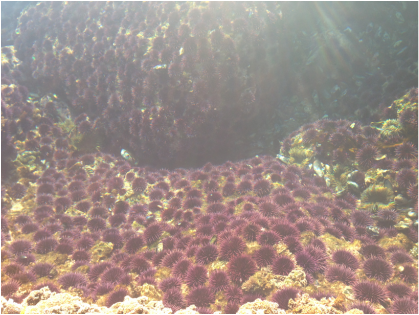 Sea urchins at Treasure Island tide pools, Laguna Beach, CA.
Sea urchins at Treasure Island tide pools, Laguna Beach, CA.
Many marine invertebrates have complex life histories including planktonic larval stages that may disperse among apparently isolated adult populations. We are interested in the impact of ocean currents, larval (and adult) behavior, breeding season, random chance events and selection on the genetic structure of different species.
Some highlights:
Some highlights:
- Despite its strong impact on species distributions, Point Conception in California has little impact on the distribution of genetic variation within species (Burton, 1998)
- Explicit test of sweepstakes recruitment hypothesis in California purple urchins (see Flowers et al., 2002)
DNA barcoding of California marine fish
|
All species have unique DNA sequences, which means that DNA sequences have obvious utility for species identification. In fact, for many groups of organisms, only specialist taxonomists can distinguish that species based on morphology. Using specimens identified by such specialists, we can now obtain species-specific DNA sequences that will permit non-specialists to identify difficult specimens. This is especially useful in identifying eggs and larval forms where morphological identification can be nearly impossible. To make such identifications possible, we need DNA sequence databases with representative sequence(s) of the same gene for each taxon. In this project, we will collect tissues, extract and preserve DNA, and obtain sequences from three mitochondrial genes (16S rRNA, cytochrome oxidase I (COI) and cytochrome b) from each of the 800+ species of marine fish found in California waters. This database will permit investigators to identify eggs, larvae and forensic samples of California marine fishes. |
Voucher specimen in SIO Collection
↓ Extract DNA ↓ PCR and sequence ↓ Sequence database |
